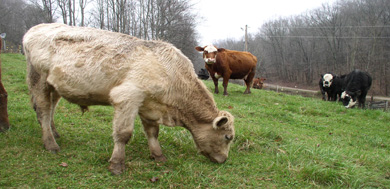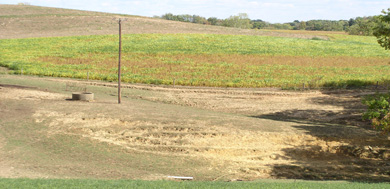Local pastures have been repeatedly stressed over the past few years. The forage plants have struggled to survive the extremely dry weather a couple of summers ago, to extremely wet seasons, including flooding in some areas, to below normal temperatures for an extended period of time this past winter.
Let us also not forget the livestock grazing during less than ideal soil conditions that have taken place and the impact of the foot/hoof traffic on the plants and soils during those times.
Management
Spring management will be critical in the recovery of the forage stands in many of these damaged areas. Hopefully, many of you have already completed a frost seeding to thicken up or renovate the stands.
Flash grazing (short duration grazing in a given area) of this area last spring allowed the animals to harvest the available forage on this field in southeastern Ohio, March 28, 2009, and still leave an adequate amount of forage to protect the soil and to quickly recover and be very productive throughout the entire grazing season.
If your pastures have significant amounts of bare soil, you may still have a short window of opportunity to complete a frost seeding, depending on your local weather conditions.
This is accomplished by broadcasting your legume seed on the mostly bare soil and letting the frost action work the seed into surface of the soil.
As the weather warms up and the soils dry out, we recommend switching to a drill for making the renovations that are needed.
Whether we are looking at the new seedlings or those recovering from several months of stress, many of the plants will be slow as they start to grow this spring.
Rest
Plan now to rest your pastures between grazing events this spring and summer to allow the root reserves to rebuild and hopefully be able to sustain the plants as we go into the summer and fall.
Utilizing temporary electric fence to establish paddocks, to allow for quick rotations and long rest periods will pay big dividends later in the grazing season.
Failure to manage and improve the forages you have now can reduce total pasture production for rest of the grazing season.
Grazing too much, too close or too often on the early spring plant growth will deplete the limited energy reserves.
The need for early spring grazing needs to be evaluated against the requirements for a healthy forage stand and the overall long term health of the pasture.
Total leaf area, day length and sunshine intensity all affect how quickly the plant will be generating enough photosynthesis to not only maintain itself but to also start to grow and provide feed for the grazing livestock.
Summer management makes all the difference in the world as well. As can be seen in this photo, the amount and type of vegetation varies greatly in a short distance based on the management of the livestock and when they have access to the area.
STAY INFORMED. SIGN UP!
Up-to-date agriculture news in your inbox!














